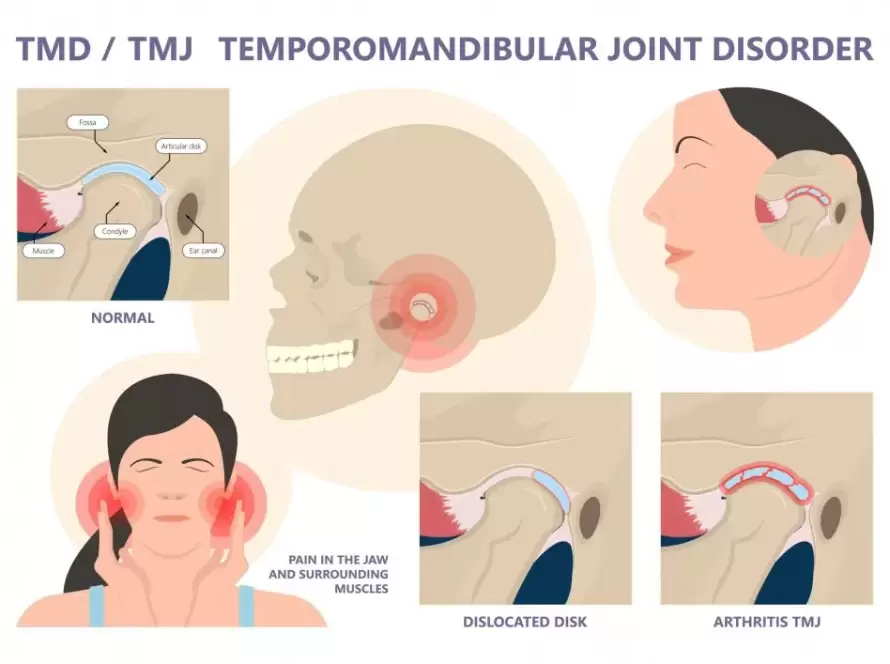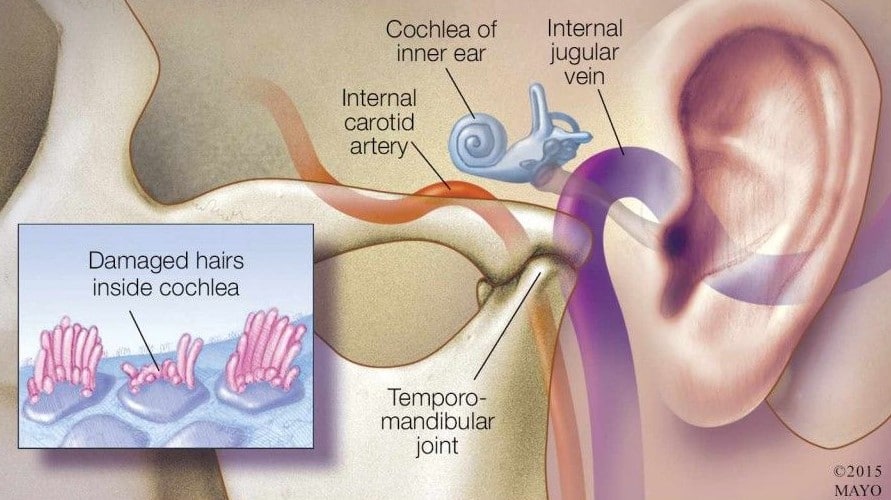TMJ disorders are commonly from muscle disorders and sometimes due to the joint (TMJ).
Simple jaw massages, warm compresses and gentle exercises can often provide a lot of relief. Massaging the temples and in front of the ears in circular fashion for 30 seconds each followed by warm compress can provide relief in masseters and temporalis which are two of the main jaw muscles which help to close the jaw. Follow this by warm compresses with moist heat (microwaveable heating pad with a wet thin cloth between the pad and skin) for 10 minutes to increase blood flow and healing. Repeat this routine at least 2-3 times per day to retrain the jaw muscles and pain signals.
Temporomandibular Joint (TMJ) disorders, often abbreviated as TMD, encompass a range of conditions that cause pain and dysfunction in the jaw joint and the muscles controlling jaw movement. The TMJ connects the mandible (lower jaw) to the temporal bone of the skull, located in front of the ears on each side of the head. It allows for the movement needed for talking, chewing, and yawning. Disorders of the TMJ can arise from problems with the joint itself or the muscles around it.

Causes and Symptoms of TMJ Disorders
Muscle Disorders: The most common TMJ disorders are related to muscle tension and spasms in the jaw, face, and neck. Factors contributing to these muscle issues include stress, teeth grinding (bruxism), and jaw clenching. These habits can lead to muscle fatigue, inflammation, and pain.
Joint Disorders: Sometimes, TMJ disorders are caused by issues within the joint itself. This could involve damage to the cartilage disk that cushions the joint, arthritis, dislocation, or trauma to the jaw.
Symptoms: Common symptoms of TMJ disorders include:
- Pain or tenderness in the jaw, face, and neck.
- Aching pain around the ear.
- Difficulty chewing or discomfort while chewing.
- Clicking, popping, or grating sounds when opening or closing the mouth.
- Locking of the joint, making it difficult to open or close the mouth.
Non-Invasive Treatment Methods
Non-invasive treatments are often the first line of defense against TMJ disorders, focusing on alleviating pain and restoring function without the need for surgery. Among the most effective and accessible methods are jaw massages, warm compresses, and gentle exercises.
Jaw Massages
Massaging the muscles around the jaw can help to reduce tension, improve blood flow, and promote relaxation. The masseters and temporalis muscles are key targets for these massages.
Technique:
- Masseter Muscle: Located at the angle of the jaw, this muscle plays a significant role in chewing.
- Use the tips of your fingers to apply gentle pressure to the masseter.
- Perform circular motions for about 30 seconds.
- Gradually increase the pressure as the muscle begins to relax.
- Temporalis Muscle: This fan-shaped muscle is situated at the temples, just above the ear.
- Place your fingers on the temples and massage in circular motions.
- Apply light pressure and move in small circles for about 30 seconds.
Regularly massaging these muscles can help to alleviate pain and prevent muscle spasms.
Warm Compresses
Applying warmth to the affected area can significantly reduce pain and promote healing by increasing blood flow.
Method:
- Use a microwaveable heating pad wrapped in a damp, thin cloth to create moist heat.
- Apply the warm compress to the side of the face where the pain is located.
- Keep it in place for about 10 minutes.
Moist heat is particularly effective as it penetrates deeper into the tissues compared to dry heat, facilitating better relaxation and relief.
Gentle Exercises
Jaw exercises can help to improve range of motion, strengthen muscles, and reduce pain. These exercises should be performed gently and progressively to avoid aggravating the condition.
Examples:
- Jaw Stretching:
- Open your mouth as wide as comfortable, then close it slowly.
- Repeat 5-10 times.
- Resistance Exercises:
- Place your thumb under your chin and push upwards gently while trying to open your mouth.
- Hold for a few seconds, then release.
- Repeat 5-10 times.
- Side-to-Side Movements:
- Move your jaw slowly from side to side.
- Repeat 5-10 times.
Routine and Consistency
For maximum effectiveness, the combination of massages, warm compresses, and exercises should be incorporated into a daily routine. Repeating these methods 2-3 times per day helps to retrain the jaw muscles, alleviating pain and reducing the recurrence of symptoms. Consistency is crucial as it allows the muscles to gradually adapt and heal.
Conclusion
TMJ disorders, whether stemming from muscle issues or joint problems, can significantly impact daily life by causing pain and limiting jaw function. Simple, non-invasive treatments such as jaw massages, warm compresses, and gentle exercises offer effective relief. By regularly applying these methods, individuals can manage their symptoms, improve jaw function, and enhance their overall quality of life. As always, if symptoms persist or worsen, it is important to consult a healthcare professional for a comprehensive evaluation and tailored treatment plan.


